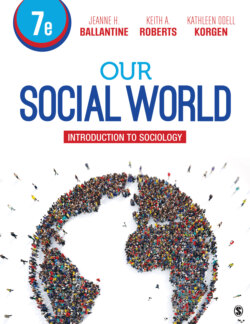Читать книгу Our Social World - Kathleen Odell Korgen - Страница 119
Culture: The Software
ОглавлениеCulture, the way of life shared by a group of people, includes the ideas and “things” passed on from one generation to the next in a society, including knowledge, beliefs, values, rules and laws, language, customs, symbols, and material products. It varies greatly as we travel across the globe. Each social unit of interdependent people, whether at the micro, meso, or macro level, develops a unique way of life with guidelines for the actions and interaction of individuals and groups within society.
As you can see, the sociological definition of culture refers to far more than “high or elite culture” shared by a select few—such as fine art, classical music, opera, literature, ballet, and theater—and also far more than “popular culture”—such as reality TV, professional wrestling, YouTube, and other mass entertainment. Popular culture is mass produced and consumed and becomes part of everyday traditions through its practices, beliefs, and material objects. It influences public opinion and values. Music, a form of pop culture, has many forms; for example, rap music often focuses on urban culture’s politics, economics, and inequality and provides an outlet for frustrations through musical commentary. Much of pop culture has been shaped by technology, as we see in texting and social media. The rapid change in this aspect of popular culture is illustrated in the next Engaging Sociology.
Engaging Sociology
Pop Culture Technology Timeline
© Getty/Bernhard Lang
How surprising to think that digital telephones, high-speed lines for computers, digitized print media, and the World Wide Web were all invented within about the past half century, many within the last 20 years. Vinyl records, dial telephones, VHS tapes, and more recently CDs and DVDs have been surpassed by smartphones and streamed and downloaded movies and music. Slim laptops, tablets, and handheld computers have replaced bulky desktop computers. The following timeline shows the advances of the Internet and World Wide Web in recent years; the point of this timeline is to illustrate the rapid advance of technology and the place it holds in our lives. Technology is now a primary conveyor of culture, especially pop culture.
An Internet and World Wide Web Timeline
1946: The first general-purpose computer is created, developed for military purposes.
1951: The first civilian computer is created.
1971: The first personal computer (PC) is launched.
1978: Cellular phone service begins.
1982: Invention of high-speed communications network leads to the Internet.
1984: Apple’s Macintosh introduces the first PC with graphics.
1991: The Internet opens to commercial use; the World Wide Web is launched.
1996: Google makes its debut.
2002: Amazon Web Services debuts, followed in 2006 by Amazon Elastic Compute Cloud.
2004: Mark Zuckerberg debuts Facebook while still a college student.
2005: YouTube is created by Chad Hurley, Steve Chen, and Jawed Karim.
2009: “Killer apps” from Microsoft and Google debut.
2013: Wristbands to collect biological data and living, breathing running shoes debut.
2014: Video glasses with head-mounted display screen debut, and smartwatches connect to the Internet and smartphones.
2015: Three-dimensional computer cursors and robotic exoskeletons are controlled by human thoughts.
2018: Genetically modified future challenges humans to think about the relationship between technology and society (Illing 2018).
The continuing rapid advances in technology have paralleled the development of shared pop culture in the United States and around the world, culture that is accessible to everyone. Music groups from other continents have gained audiences in the United States, with some becoming instant success stories through YouTube.
